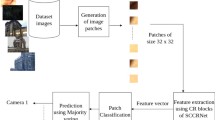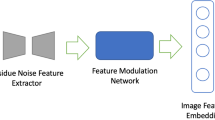Abstract
This paper focuses on source camera model identification technology in the field of digital image forensics. The research goal is to identify the source camera model, and researchers generally use the algorithm design of convolutional neural networks combined with noise residuals. However, traditional features such as noise residuals are easily polluted by noise and compression, which substantially affects the classification accuracy of source camera model identification algorithms for traditional features. Based on existing source camera model identification methods, this paper proposes the use of color correction features as the basic features of source camera model identification for the first time and proposes a new algorithm for source camera model identification based on image color correction features. A convolutional neural network is utilized to extract image color correction features and identify and classify source camera models. This paper has carried out experimental verification on a large-scale dataset, and the source camera model recognition accuracy of the proposed method in this paper can reach 97.23%; the recognition accuracy under compression conditions has reached 91.28%. The experimental results show that the image color correction feature is better than the source camera model in terms of recognition and has great research and application potential in the field of recognition. Additionally, the proposed algorithm is highly robust even after image compression and pollution, outperforming other methods under both original image conditions and compressed image conditions.







Similar content being viewed by others
Data availability
The results of all published algorithms can be obtained from the websites provided by their respective authors.
Abbreviations
- CCM:
-
Color correction matrix
- AWB:
-
Auto white balance
- CFA:
-
Color filter array
- PRNU:
-
Photo Response Non-Uniformity
- V ccm :
-
Color correction matrix vector
- V cnn :
-
CNN vector
References
Wang B, Wang Y, Hou J et al (2021) Discriminative feature projection for camera model identification of recompressed images. Multimed Tools Appl 80(19):29719–29743
Bernacki J (2020) A survey on digital camera identification methods. Forensic Sci Int Digit Investig 34:300983
Sameer VU, Naskar R (2020) Deep siamese network for limited labels classification in source camera identification. Multimed Tools Appl 79(37):28079–28104
Wang B, Zhong K, Li M (2019) Ensemble classifier based source camera identification using fusion features. Multimed Tools Appl 78(7):8397–8422
Lorch B, Schirrmacher F, Maier A et al (2021) Reliable camera model identification using sparse gaussian processes. IEEE Signal Process Lett 28:912–916
Wang B, Zhong K, Shan Z et al (2020) A unified framework of source camera identification based on features. Forensic Sci Int 307:110109
Lin X, Li CT (2016) Enhancing sensor pattern noise via filtering distortion removal. IEEE Signal Process Lett 23(3):381–385
Chen C, Stamm MC (2021) Robust camera model identification using demosaicing residual features. Multimed Tools Appl 80(8):11365–11393
Tomioka Y, Ito Y, Kitazawa H (2013) Robust digital camera identification based on pairwise magnitude relations of clustered sensor pattern noise. IEEE Trans Inf Forensics Secur 8(12):1986–1995
Lukas J, Fridrich J, Goljan M (2006) Digital camera identification from sensor pattern noise. IEEE Trans Inf Forensics Secur 1(2):205–214
Tuama A, Comby F, Chaumont M (2016) Camera model identification with the use of deep convolutional neural networks[C]//2016 IEEE International workshop on information forensics and security (WIFS). IEEE: 1–6
Yao H, Qiao T, Xu M et al (2018) Robust multi-classifier for camera model identification based on convolution neural network. IEEE Access 6:24973–24982
Cai T, Shao Z, Tomioka Y et al (2019) CNN-based camera model identification using image noise in frequency domain[C]//2019 IEEE International Conference on Systems, Man and Cybernetics (SMC). IEEE : 3518–3524
Roy A, Chakraborty RS, Sameer VU et al (2017) Camera source identification using discrete cosine transform residue features and ensemble classifier[C]//CVPR Workshops: 1848–1854
Gupta B, Tiwari M (2018) Improving source camera identification performance using DCT based image frequency components dependent sensor pattern noise extraction method. Digit Investig 24:121–127
Rao Q, Wang J (2017) Suppressing random artifacts in reference sensor pattern noise via decorrelation. IEEE Signal Process Lett 24(6):809–813
Van LT, Emmanuel S, Kankanhalli MS (2007) Identifying source cell phone using chromatic aberration[C]//2007 IEEE International Conference on Multimedia and Expo. IEEE: 883–886
Deng Z, Gijsenij A, Zhang J (2011) Source camera identification using auto-white balance approximation[C]//2011 International Conference on Computer Vision. IEEE: 57–64
Long Y, Huang Y (2006) Image based source camera identification using demosaicking[C]//2006 IEEE Workshop on Multimedia Signal Processing. IEEE: 419–424
Kharrazi M, Sencar HT, Memon ND et al (2004) Blind source camera identification[C]. IEEE International Conference on Image Processing. Singapore: 709–712
Uchida M, Tomioka Y (2020) CNN-based camera model classification and metric learning robust to JPEG noise contamination[C]//2020 11th International Conference on Awareness Science and Technology (iCAST). IEEE: 1–7
Rizzi A, Gatta C, Marini D (2003) A new algorithm for unsupervised global and local color correction. Pattern Recogn Lett 24(11):1663–1677
Mantiuk R, Mantiuk R, Tomaszewska A et al (2009) Color correction for tone mapping[C]//Computer Graphics Forum. Oxford, UK: Blackwell Publishing Ltd 28(2): 193-202
Lee SH, Choi JS (2008) Design and implementation of color correction system for images captured by digital camera. IEEE Trans Consum Electron 54(2):268–276
Han Z, Jin W, Li L et al (2020) Nonlinear regression color correction method for RGBN cameras. IEEE Access 8:25914–25926
Galdi C, Hartung F, Dugelay J L(2019) SOCRatES: A Database of Realistic Data for SOurce Camera REcognition on Smartphones[C]//8th International Conference on Pattern Recognition Applications and Methods. https://doi.org/10.5220/0007403706480655
Shullani D, Fontani M, Iuliani M et al (2017) VISION: a video and image dataset for source identification. EURASIP J Inf Secur 2017(1):1–16
Hadwiger B, Riess C (2021) The Forchheim image database for camera identification in the wild[C]//International Conference on Pattern Recognition. Springer, Cham: 500–515
Bayar B, Stamm MC (2017) Design principles of convolutional neural networks for multimedia forensics. Electron Imaging 2017(7):77–86
Tuama A, Comby F, Chaumont M (2016) Camera model identification with the use of deep convolutional neural networks[C]. 2016 IEEE International workshop on information forensics and security (WIFS). Abu Dhabi: IEEE, 2016
Bondi L, Baroffio L, Güera D et al (2016) First steps toward camera model identification with convolutional neural networks. IEEE Signal Process Lett 24(3):259–263
Rafi AM, Tonmoy TI, Kamal U et al (2021) RemNet: remnant convolutional neural network for camera model identification. Neural Comput Appl 33:3655–3670
Funding
This work was supported by the Zhejiang Provincial Key Lab of Equipment Electronics, Hangzhou, China.
Author information
Authors and Affiliations
Contributions
Conceptualization, Y.L. and C.C.; Formal analysis, Y.L. and C.C.; Investigation, C.C., Z.L. and Y.L.; Methodology, Z.L. and C.C.; Project administration, Z.L.; Resources, C.C.; Validation, C.C., H.L. Writing—original draft, C.C.,H.L.; Writing—review & editing, C.C., Y.L. and Z.L..
Corresponding author
Ethics declarations
Declarations
Not applicable.
Ethics approval
Not applicable.
Consent to participate
Not applicable.
Consent for publication
Written informed consent for publication was obtained from all participants.
Conflicts of interest/Competing interests
We declare that we do not have any commercial or associative interest that represents a conflict of interest in connection with the work submitted.
Additional information
Publisher's Note
Springer Nature remains neutral with regard to jurisdictional claims in published maps and institutional affiliations.
Rights and permissions
Springer Nature or its licensor (e.g. a society or other partner) holds exclusive rights to this article under a publishing agreement with the author(s) or other rightsholder(s); author self-archiving of the accepted manuscript version of this article is solely governed by the terms of such publishing agreement and applicable law.
About this article
Cite this article
Liu, Y.y., Chen, C., Lin, Hw. et al. A new camera model identification method based on color correction features. Multimed Tools Appl 83, 29179–29195 (2024). https://doi.org/10.1007/s11042-023-16693-z
Received:
Revised:
Accepted:
Published:
Issue Date:
DOI: https://doi.org/10.1007/s11042-023-16693-z




